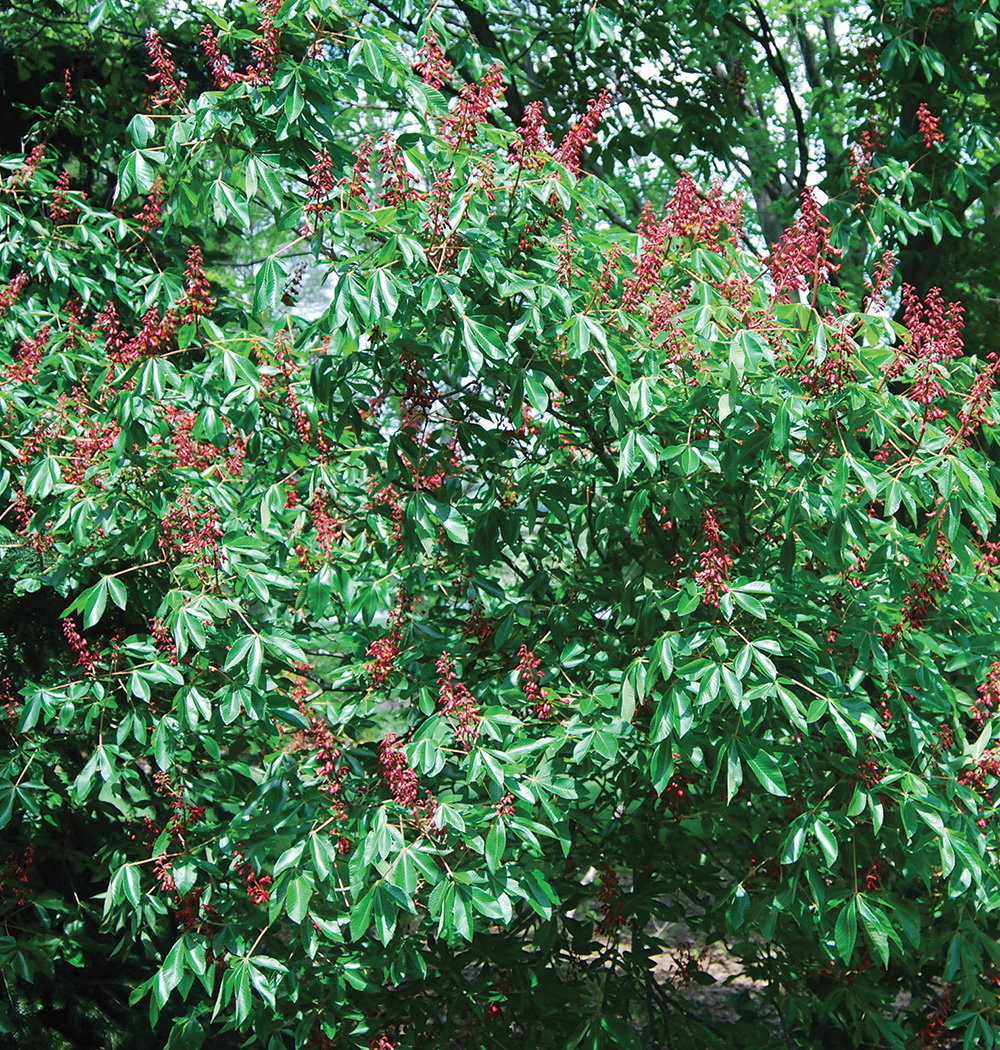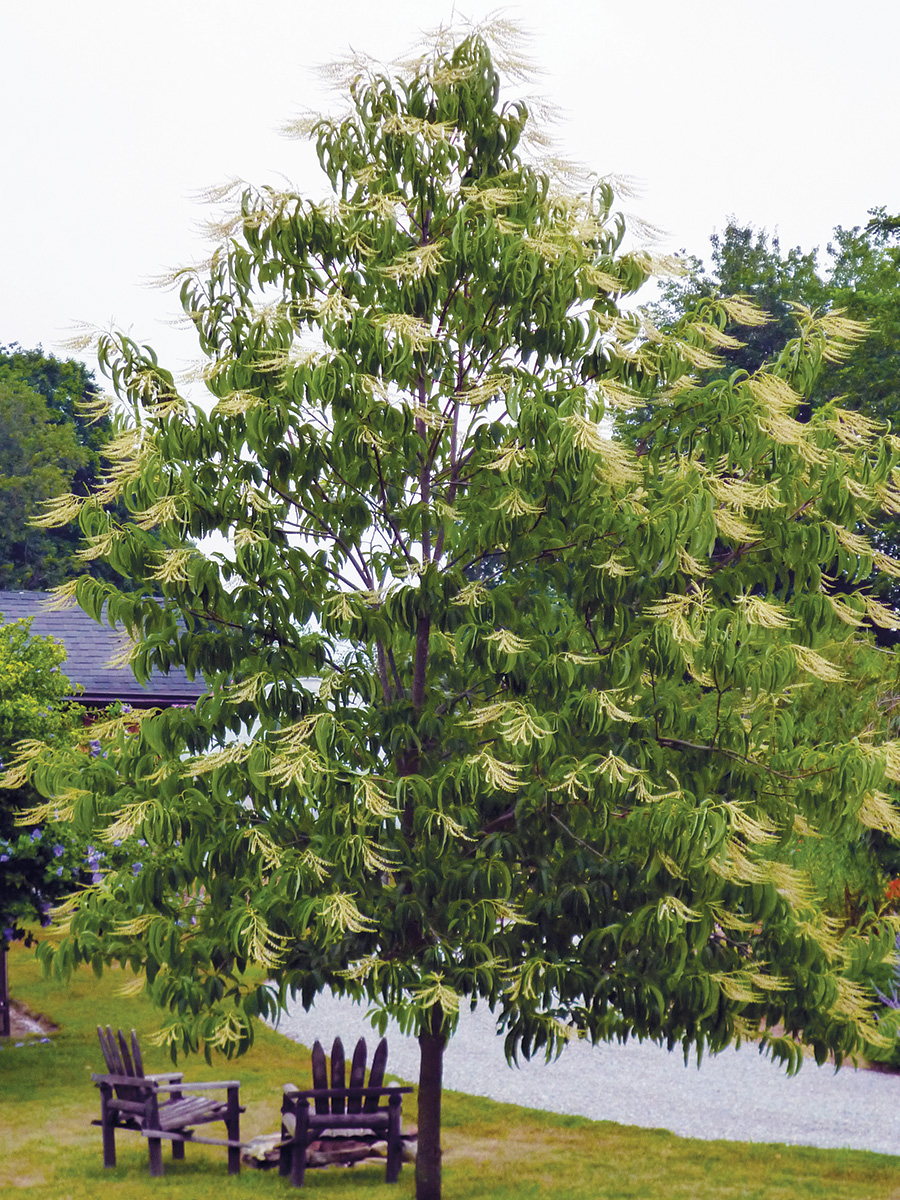While gardeners often extol the virtues of outstanding bark and winter interest, let’s not kid ourselves—flower power reigns supreme. A tree that is a stately focal point most of the year will be transformed into an awe-inspiring centerpiece by spectacular blooms. Spring-flowering trees often occupy prime garden real estate, but for some easy, unexpected floral elegance, it is truly worthwhile to plant trees that bloom in summer, fall, or even late winter. Many of my favorites even have dazzling displays when they aren’t in bloom. Here are some excellent choices for you to consider.
Early Bloomers Chase Winter’s Chill Away
When it seems like spring will never come, seeing branches laden with buds gives us hope that warmer weather is on its way.
‘Appalachian Red’ redbud illuminates the garden with a unique hue
Name: Cercis canadensis ‘Appalachian Red’
Zones: 4–9
Size: 15 to 25 feet tall and wide
Conditions: Full sun to partial shade; moderately moist, well-drained soil
Native range: Eastern and central North America
First bloom: Early spring
Redbud is going to be on almost every list of spring-flowering trees. If I had to choose just one for its color and impact, this would be it. New cultivars with unique growing forms or foliage have flooded the market, but cultivars with distinctly different flower colors are hard to find. In this category, ‘Appalachian Red’ is a real standout with its reddish-pink, pealike blooms. Found over 30 years ago by Max Byrkit near the Appalachian Trail in Maryland, it is a true classic that will set your spring garden apart from the crowd.
Japanese flowering apricot adorns its bare branches with graceful, timeless blooms

Name: Prunus mume
Zones: 6–9
Size: 15 to 20 feet tall and wide
Conditions: Full sun to partial shade; moist, acidic, humus-rich soil
Native range: Central and southern China
First bloom: Late winter
During a gray-sky week in late January, I can often count on this early bloomer to brighten my day. “Underutilized” is an understatement for this delightful small tree, which really should be grown more widely. Japanese apricot flowers when few other trees are in bloom. Hundreds of cultivars are available in shades of pink, white, and red, and in both single and double forms. Its season of beauty is extended by its exfoliating bark, which reveals beautiful cinnamon undertones where it falls away.
‘Humilis’ red buckeye is a perfect fit for smaller landscapes

Name: Aesculus pavia ‘Humilis’
Zones: 4–8
Size: 15 feet tall and wide
Conditions: Full sun to partial shade; moist, well-drained soil
Native range: Eastern North America
First bloom: Early to mid-spring
When it is first planted, ‘Humilis’ will be shrublike, but as it matures it will gradually transition into a small deciduous tree. Its leaves emerge very early in the season, preceding the 4- to 8-inch panicles of flowers that appear to float above the foliage. These often emerge just as the fear of frost starts to dissipate. Compared to the straight species, which can grow 20 or 30 feet tall, ‘Humilis’ has a more compact stature, and its flower clusters are smaller.
Summer Bloomers Should Offer Multiple Seasons of Interest
As the garden year rolls toward its peak, it’s helpful to have focal points that elevate and harmonize with ground-level flushes of color.
Bigleaf magnolia could easily become a neighborhood landmark

Name: Magnolia macrophylla
Zones: 5–8
Size: 30 to 40 feet tall and wide
Conditions: Full sun to partial shade; moist, rich, well-drained soil
Native range: Southeastern United States, eastern Mexico
First bloom: Early to midsummer
With fragrant, 16-inch flowers and leaves up to 2 or 3 feet long, bigleaf magnolia looks almost too tropical for words. In fact, it has the largest simple leaves and flowers of any deciduous tree indigenous to North America. It prefers a sheltered spot with moist, fertile soil. Give it plenty of room to grow; if its loosely pyramidal habit is not crowded, its limbs will often stretch low and wide, bringing those spectacular flowers down to eye level.
American smoke tree provides airy texture and sizzling fall color


Name: Cotinus obovatus
Zones: 3–8
Size: 20 to 30 feet tall and wide
Conditions: Full sun to partial shade; average to dry, well-drained soil
Native range: Southern United States
First bloom: Midsummer
It is a true experience to see an American smoke tree in its full, billowy glory. The individual flowers are tiny and not that special, but the spent flower clusters transform into giant, smokelike pink puffs as the season progresses. After these fade, its fall foliage color stands out as one of the most vibrant and consistent of North American native trees. Over time, this plant transforms from a large shrub to a lovely and distinctive small tree.
Empress of China® dogwood flowers for weeks on end

Name: Cornus elliptica ‘Elsbry’
Zones: 6–9
Size: 15 to 20 feet tall and 12 to 15 feet wide
Conditions: Full sun to partial shade; moderately moist, well-drained soil
Native range: China
First bloom: Early to midsummer
Empress of China® dogwood will surprise you. First, it is almost entirely evergreen through the winter months, finally shedding its leaves in spring when new foliage begins to appear. Second, it blooms far later than most garden-worthy dogwoods. A mature tree will be covered with flowers on every branch, and the display lasts for several weeks—from early summer until midsummer. Empress of China® is the most commercially available selection from the species; it is very vigorous and blooms well as a young plant. For the best show, site it in a spot that gets morning sun and afternoon shade.
Late Bloomers Bring the Growing Season to a Stylish Close
For a refreshing boost of garden energy, find a tree that peaks when many perennials and shrubs are flagging in the heat. For some of these trees, the seeds that follow are even cooler than the floral display.
Variegated Japanese aralia tops flashy foliage with foamy starbursts

Name: Aralia elata* ‘Variegata’
Zones: 4–8
Size: 10 to 15 feet tall and 6 to 10 feet wide
Conditions: Full sun to partial shade; average to moist, well-drained soil
Native range: Northeastern Asia
First bloom: Mid to late summer
Perhaps this is a guilty pleasure and more of a diva than other plants listed, but variegated Japanese aralia is a plant that stops me in my tracks whenever I see it. At the height of summer, massive white flowers appear in huge panicles measuring 12 to 18 inches in diameter. The flowers are complemented by huge compound leaves that can approach 3 feet long. Cultivars like this are grafted onto root stock of the straight species, so care needs to be taken to control the nonvariegated suckers that often develop. There’s no denying that this tree is a bit high-maintenance; whether it’s worth the effort is up to you.
Sweetheart tree saves its best display for the end of summer

Name: Euscaphis japonica
Zones: 6–8
Size: 12 to 20 feet tall and wide
Conditions: Full sun to partial shade; moderately moist, well-drained soil
Native range: China, Korea, Japan
First bloom: Late spring to early summer; showy seeds form in late summer
Sweetheart tree is actually an early summer bloomer, forming broad panicles of yellowish-white flowers. However, it is what happens next that will capture your attention. In the last part of summer, seedpods with a pink exterior and red interior begin to form, and as each pod opens it reveals a shiny black seed. As a fall finale, its shiny, compound leaves turn a coppery purple. Euscaphis is still being tested by gardeners to fully assess its garden worthiness, but my vote is yes.
Sourwood is showy from midsummer through fall


Name: Oxydendrum arboretum
Zones: 5–9
Size: 20 to 30 feet tall and 10 to 15 feet wide
Conditions: Full sun to full shade; moist, organically rich, well-drained soil
Native range: Eastern United States
First bloom: Mid to late summer
Sourwood often blooms in early July here in the Southeast, and its relatively large, drooping panicles of bell-shaped flowers persist for several weeks. These are very charming in their own right, and when they fade you will get an extended period of interest as the seeds develop. Spent inflorescences remain present and beautiful through fall, and autumnal foliage coloration is spectacular with bright reds, purples, and yellows present on different populations. This tree is not fond of urban conditions or of being transplanted as a large specimen.
*Invasive Alert:
Japanese aralia (Aralia elata)
This plant is considered invasive in MD, NH, NJ, NY, and PA.
Please visit invasiveplantatlas.org for more information.
Andy Pulte, Ph.D., is a faculty member in the plant sciences department at the University of Tennessee.
Photos, except where noted: millettephotomedia.com
Sources
The following mail-order sellers offer many of the plants featured here:





